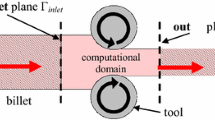Abstract
A Meshless approach based on a Reproducing Kernel Particle Method is developed for metal forming analysis. In this approach, the displacement shape functions are constructed using the reproducing kernel approximation that satisfies consistency conditions. The variational equation of materials with loading-path dependent behavior and contact conditions is formulated with reference to the current configuration. A Lagrangian kernel function, and its corresponding reproducing kernel shape function, are constructed using material coordinates for the Lagrangian discretization of the variational equation. The spatial derivatives of the Lagrangian reproducing kernel shape functions involved in the stress computation of path-dependent materials are performed by an inverse mapping that requires the inversion of the deformation gradient. A collocation formulation is used in the discretization of the boundary integral of the contact constraint equations formulated by a penalty method. By the use of a transformation method, the contact constraints are imposed directly on the contact nodes, and consequently the contact forces and their associated stiffness matrices are formulated at the nodal coordinate. Numerical examples are given to verify the accuracy of the proposed meshless method for metal forming analysis.
Similar content being viewed by others
Author information
Authors and Affiliations
Rights and permissions
About this article
Cite this article
Chen, JS., Pan, C., Roque, C. et al. A Lagrangian reproducing kernel particle method for metal forming analysis. Computational Mechanics 22, 289–307 (1998). https://doi.org/10.1007/s004660050361
Issue Date:
DOI: https://doi.org/10.1007/s004660050361




